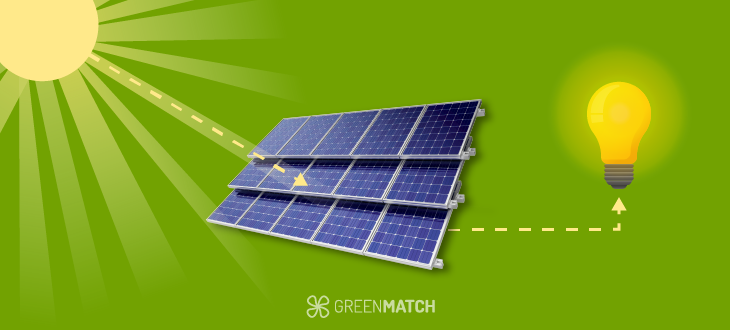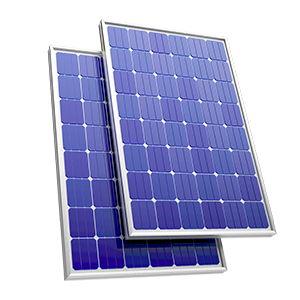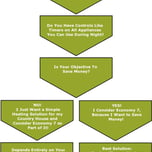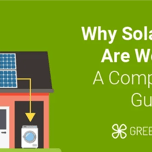Answer these simple questions and we will find you the BEST prices
Which type of solar quotes do you need?
It only takes 30 seconds
100% free with no obligation

Get up to 4 quotes by filling in only 1 quick form

Slash your energy bills by installing solar panels

For the average 2-3 bedroom house
- GreenMatch
- Blog
- How Do Solar Panels Work?
How Do Solar Panels Work? (April 2025 Guide)


Commercial solar panels and residential solar panels have become a regular part of our suburban landscape. Crowning the tops of buildings and homes for many years, we still wonder how solar panels work.
In short, solar panels absorb sunlight and convert it into electricity using specialised structures within the panels known as ‘photovoltaic cells’. These clever cells produce an electrical current that we can convert for use around our homes.
Not only is this incredible technology, but it’s also a completely clean, renewable energy source, providing an alternative to fossil-fuelled power. It’s reducing carbon emissions and saving people hundreds of pounds on ever-increasing energy bills.
In this article, we’ll take a more detailed look at how solar panels work, their components, and the advantages and disadvantages of solar energy for our planet.
How do solar panels generate electricity?
Photovoltaic panels convert energy from the sun’s energy into usable electricity. The number of panels you install on your roof will determine how much they can generate - more panels mean more electricity.
It sounds straightforward, but some clever science goes inside a solar panel. Here’s how it works, step-by-step:

1. Solar panels are metal sheets inside a glass casing that contain a series of ‘cells’ known as Photovoltaics (PV).
Inside these photovoltaic cells is a thin, semi-conductive material from two silicon layers. One layer is positively charged, and the other is negatively charged, creating an electric field.
2. When sunlight hits the PV solar cell, it causes motion within the electric field, generating an electrical current. (There is more to this on a molecular level, as electrons detach from atoms within that semiconductor material - but we are here to keep things simple!)
3. Once the electric current is generated, it can be redirected from the solar panels. At this point, the electricity produced is in a form known as a direct current (or DC), and for us to use this on our electrical devices at home, it needs to be converted to an alternating current (AC).
4. To do this, a piece of equipment known as a solar inverter takes the DC electricity and changes it to AC, ready to be sent around the household.
An inverter is a crucial part of a solar power system and can be installed inside or outdoors. They require a cool, ventilated atmosphere to work most efficiently, so indoor installation is recommended in a utility room or garage.
In solar power systems, you use two types of inverters: a ‘string inverter’ (a central inverter) or a mico-inverter. Micro-inverters are used only on individual solar PV panels and are not likely to be seen in larger systems.
A string inverter will be used for most home setups requiring multiple solar panels. This is so-called because each solar panel is wired into a central inverter (much like a series of strings coming together).
In some modern models, the inverter can also be used as a point to monitor your power generation and usage levels. Depending on the model, you can access these details online or through an app.
5. From here, you now have a usable source of electricity that can power your home. Two things can happen next - you can use the produced electricity or store any that you don’t use in a solar battery. You may also benefit from selling back electricity to the grid.
Since 2020, under the Smart Export Guarantee, homeowners in England, Scotland, and Wales have been able to receive payments for each renewable energy unit they produce and export to the grid. This could lower the costs of solar panels in Scotland, England and Wales.
To learn more about this scheme and other ways to save money with solar panels, look at our guide to ‘Solar Panel Grants and Schemes’.
Advantages of having solar panels at home
A wide range of benefits come with installing solar panels at your home. Here are some of the advantages that homeowners can enjoy:
-
Saving money:
You no longer need to rely on a grid supplier as you produce your electricity supply. This will cut down your bills drastically. The only electricity expenditure you need to consider is if you use the grid during the night.
-
Reduce your carbon emissions:
If you’re looking for a way to go green and cut down harmful emissions, solar panels are one of the best steps you can take. As most electricity suppliers use fossil fuels (such as oil or coal) to produce power, they create harmful carbon dioxide. Solar power doesn’t do this. It is a clean, non-polluting, renewable energy source - that is also free!
-
Becoming independent from the grid:
The National Grid provides most people with electricity, and whilst it mostly comes from harmful fossil fuels, it’s also prone to sharp, unstable price changes. By switching to your supply, you can become less dependent on the grid.
-
Low Maintenance:
Solar panels have a long life span of 25-30 years and come with average warranties of around 20+ years, meaning you don’t have to worry about expensive replacements or constant upgrades.
-
Earn Money:
Through various incentives and schemes, homeowners with solar panels may be able to receive payments for any excess electricity through solar net-metering. This helps significantly in recouping the cost of the installation, making it a long-term investment.

Types of solar power technology
When you read about solar panels, you might come across terminology that doesn’t make much sense. In particular, when you read about different types of solar panel materials or additional technology that helps support solar panels to work.
Here are some of the most common terms and technologies and what they do.
Solar photovoltaic panels (PV panels) Vs. Solar thermal panels
There are two main types of solar panels that you will come across. Solar PV panels are standard panels which produce electricity. Solar thermal panels, however, generate heat. Both systems use sunlight as an energy source but produce very different things!
Solar PV is what you're looking for to generate usable electricity to power your home. If you wish to heat your hot water for your central heating and outlets, solar thermal is what you need.
Solar panel materials: Monocrystalline, Polycrystalline or Thin-Film?
Perhaps the more complex area you might stumble into when researching solar panels is the material you want to choose.
Most of us imagine there is one standard form of solar panel, but there are at least 3 types you can use. Each has advantages and disadvantages, ranging from cost, efficiency, size and lifespan.
Depending on your needs and the type of building, budget and space, one material may suit your circumstances better than the others.
You can dive deeper into the details in our section on ‘Types of Solar Cells?’ for a more comprehensive comparison.
What are solar batteries?
Solar batteries are an additional storage solution for any excess solar energy your solar PV panels might generate. They are hugely beneficial because they can be a backup energy source when your solar panels aren’t producing enough electricity.
Solar PV panels are great at producing high energy levels during daylight hours, but they will stop generating that flow at nightfall or on a mainly cloudy day. When this happens, your home will likely need to access energy from the National Grid, which will incur charges. However, if you have a solar battery installed, this can help cover those times when generation is low.
The most significant benefit of solar batteries is that they allow your home to run independently of the electric grid, drastically reducing energy costs. It also means you can operate your home on a fully renewable energy source. This is possible with solar batteries like the Tesla Powerwall in the UK.
Like solar panels, solar batteries come in many forms and can be bought in different sizes and materials. To ensure you get the best option to compliment your solar panels, read our guide on ‘solar storage batteries prices‘.
Can solar panels work in different weather conditions?
It’s common to think that solar panels will only work on the hottest days, with the most direct sunlight - but this isn’t the case. Solar panels can still generate power in almost any type of weather.
Whether there are clouds, rain or even snow, solar panels can still generate electricity if exposed to a certain level of sunlight. The only difference is that they won’t produce as much as they would on a brighter day.
Severely overcast, cloudy days will impact your solar power levels if the cloud cover lasts most of the day. One way to determine if your solar panels are getting any sun is to check for shadows outside. If shadows are being produced, your panels will likely get some sunlight. No shadows would suggest the clouds are too thick for any sun to get through.
You must understand your unique solar panel setup, especially before you purchase - such as your location, the material used in the panels, and how you will source electricity should your supply drop in cloudy weather. These aspects will impact their performance and give you the best chance to avoid problems.
How much do solar panels cost?
Getting an idea of how much solar panels might cost can be tricky, as it depends entirely on your unique circumstances and the type of solar panels you choose.
The standard cost of solar panels is between £5,000 - £11,000. The more panels you need and the size of your home will determine where you sit within this figure.
Solar panel systems are priced by kilowatt size. For example, a 4kW system (a rough average for a UK home) will cost around £6,000. However, you will need to know how much electricity you want your panels to produce for your home and how you will use them to ensure you get the correct number of panels for your needs.
We recommend speaking to professionals to get the best idea of how much solar panels cost. By getting multiple quotes from qualified installers, you can get trustworthy advice and find the best prices simultaneously!
How to get the most from solar panels
Solar panels can last over 25 years, making them a worthwhile investment. However, if your solar panels are not performing efficiently, they will disappoint you.
Whilst solar panels can be highly effective at producing clean, renewable energy for your home, there are a few key points to be aware of that can prevent you from getting the most out of your system.
Plan for lack of sunlight
Solar panels work most efficiently during daylight hours, meaning they become less efficient, and produce less energy when it’s dark. This doesn’t just mean nightfall; it can also mean that during low light seasons, such as winter, they won’t produce as much electricity during the day to power your home.
Remember this if you plan to use solar energy as your primary power source. The time of day and season will need to be planned for, and alternative energy (or stored energy) will need to be used instead. This can be covered by switching to the grid during low production times or having a sufficient solar storage battery to rely on.
Solar panel location
No matter how powerful your solar panels might be, if they aren’t installed correctly, you could find they are not producing energy. The placement of solar panels is key to ensuring they work well, so you need to check with a qualified installer that your home is in a suitable location and your panels can be placed to obtain optimal sunlight.
If tall buildings or trees surround your home or are constantly overshadowed by other large structures, you might struggle to get enough sunlight to your panels. This will severely affect how much energy they can generate.
Checking that you also have enough space on your roof will ensure you can install enough panels to produce the right amount of power for your home's needs.
All of these details, however, are something that a trusted installer will check and confirm for you ahead of any work, so you won’t have to worry about installing solar panels that you can’t use!
How can I get solar panels for my home?
Solar panels significantly reduce your home's electricity bills and support the planet's health. By switching to a renewable energy source, you can get freedom from volatile fossil fuel prices and benefit from an independent electricity generation source (which you can even be paid to produce!)
If you want to get started on your journey with the benefits of solar panels, why not let us help?
We can put you in touch with up to 3 qualified solar installers in your area who can help you plan your installation and offer you their very best prices.
We only work with the highest quality professionals, so you know you can trust their advice. Best of all, getting quotes is free, and no obligation is attached. Click the link to get your best deal on solar panels in no time!
- Quotes from local engineers
- Payment by finance available
- Save up to £1,110 per year
It only takes 30 seconds



Frequently Asked Questions
Solar panels produce power by converting the sun’s energy into usable electricity. Our step-by-step guide will take you through the process – without getting bogged down in technical terms!
In theory, no! But this would rely on you producing all of your own renewable electricity and not requiring any from the grid.
To do this you will need to ensure you install the right number of solar panels to fulfil your electrical needs. You will also need to install a solar battery, so that you can use solar power during the night, or when there is not enough sunlight to produce electricity.
The number of solar panels a house will need is determined mostly by how much electricity it uses. The more panels you have the more solar energy you can produce.
A typical home may need between 3 – 6 kilowatt hours of energy daily, but each home is different and will require varying sizes and types of solar technology to meet their demands.
Solar panels work in most weather conditions, but very heavy or overcast days can slow down the production rate of some solar panels.
As long as there is adequate sunlight, for most hours in the day, your solar panels will produce power. It’s important however, that you have a back up power source for days like these, if you intend to power your home only on solar power (such as a solar battery).
On average, solar panels have a lifespan of around 25 to 30 years. However, with proper maintenance they can continue to generate electricity beyond this.
To get the most out of solar panels, you should carefully consider the quality of the panels, your location and who you choose to install them.
No, they will not work unless there is sunlight to generate electricity. During the night, you will need to source power from and alternative supply, like a solar battery.
Many solar energy systems are also connected to the grid and can draw electricity from it during nighttime.

Becky is an experienced SEO content writer specialising in sustainability and renewable trends. Her background in broadcast journalism inspires reliable content to help readers live more sustainably every day.
We strive to connect our customers with the right product and supplier. Would you like to be part of GreenMatch?




